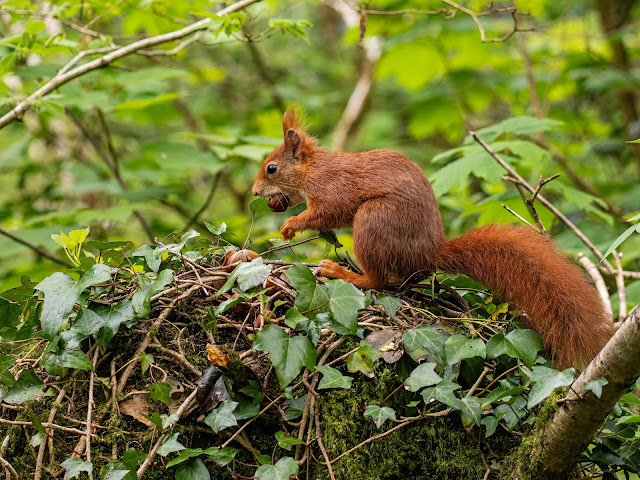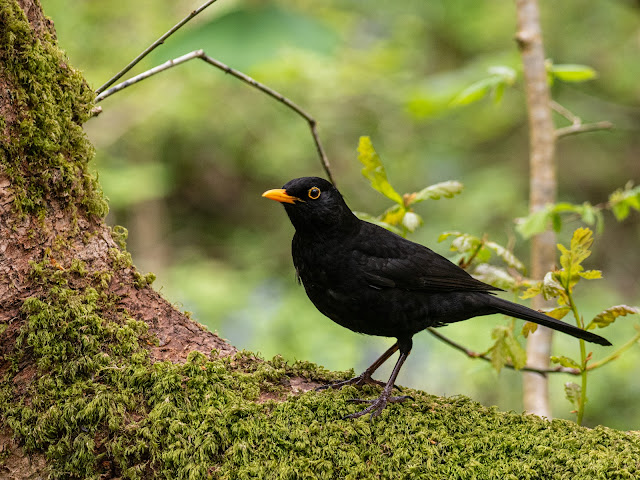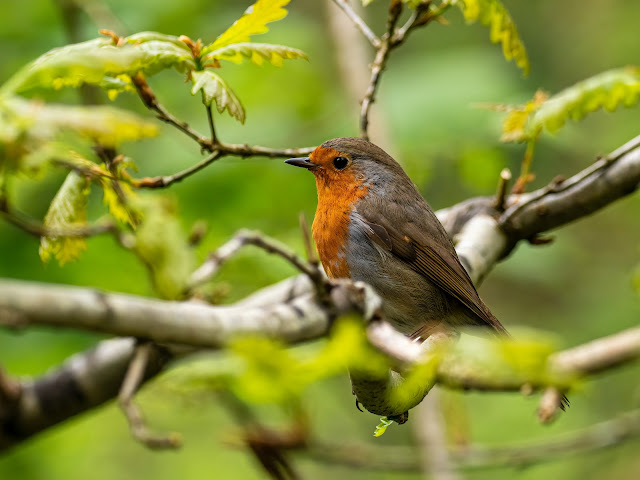On 3rd May 2024, I visited the following sites:
World's End and the Ruabon Moors, Denbighshire
Nant Ffrancon in the Snowdonia National Park, Gwynedd
LNR Dingle, Llangefni, Anglesey
RSPB South Stack and Holyhead Harbour, Anglesey
RSPB Cors Ddyga, Anglesey
After my overnight stay at Travelodge Solihull, I drove to World's End in north east Wales.
World's End is a narrow valley located
between Wrexham and Llangollen. It lies at the head of
the Eglwyseg Valley enclosed by the cliffs of Craig y Forwyn,
Craig y Cythraul and Craig yr Adar. A remote 11 mile single track road
with panoramic views between the small village of Minera and
Llangollen crosses Esclusham Mountain and the Ruabon Moors to a public car park at the top of the Eglwyseg valley.
I have visited World's End many times and it is an exceptionally good site for upland birds including a well-known Black Grouse lek. However, this was my most challenging visit to the site due to the dense hill mist which made birding almost impossible.
As always, I arrived at the Black Grouse lek early at around 6 a.m. and noisy displaying male birds were already evident, albeit views of the birds were the worst that I have had due to the misty conditions.
Due to the poor weather, my species count was significantly less than on past visits and I failed to record Wheatear, Whinchat, Common Whitethroat, Grasshopper Warbler, Cuckoo or any raptors as on previous visits.
However, my visit was still relatively successful and highlights from the road between Minera and Llangollen included the following (heard only records in italics): Black Grouse (11 males at the lek and 1 other male distantly further south), Red Grouse (2 males and 1 female seen plus at least 2 other calling males heard), Stonechat (1 pair plus 1 other male), Willow Warbler (5 singing males heard), Chiffchaff (1 singing male), Skylark (1 singing male heard), Meadow Pipit (c.10), Canada Goose (2 pairs with goslings)
Additions to 2024 UK year list: Black Grouse, Red Grouse
Here are some photos from my visit ....
Photo: female Red Grouse
After my visit to World's End, I drove to Nant Ffrancon in the Snowdonia National Park.
Nant Ffrancon is located between Bethesda and Llyn Ogwen. It contains the A5 Holyhead to London trunk road, which was re-engineered by Thomas Telford between 1810 and 1826, but a parallel minor single track road also provides access to some very good habitat for upland birds. Nant Ffrancon itself is a steep-sided glacial valley dropping to Bethesda between the Glyderau and Carneddau mountains of Snowdonia.
Nant Ffrancon is a site that I have visited several times although recent visits have not been as productive as on previous occasions. Unfortunately, I failed to see Ring Ousel, Twite, Common Redstart or Cuckoo, all of which I have recorded during some previous visits.
The highlights from my visit included the following (heard only records in italics): Pied Flycatcher (1 singing male), Wheatear (5), Tree Pipit (1), Willow Warbler (at least 5 singing males), Chiffchaff (1 singing male), Swallow (2), Stonechat (2), Mistle Thrush (2), Linnet (2), Meadow Pipit (c.5), Great Spotted Woodpecker (1 calling bird), Mallard (1 male)
Addition to 2024 UK year list: Pied Flycatcher
After my visit to Nant Ffrancon, I drove to Anglesey.
My first visit was to LNR Dingle. This is a site that I had not visited before and I only became aware of it by watching a video uploaded by Dan Willis …. see here.
LNR Dingle is a small local nature reserve in the town of Llangefni and the main attraction is undoubtedly its Red Squirrels which are incredibly easy to see and photograph. In addition, there is an abundance of common woodland birds.
Here are some photos from my visit ....
Photo: Red Squirrel
Photo: Red Squirrel
Photo: Red Squirrel
Photo: Red Squirrel
Photo: Red Squirrel
Photo: Red Squirrel
Photo: Red Squirrel
Photo: Red Squirrel
Photo: Red Squirrel
Photo: Red Squirrel
Photo: Robin
Photo: Robin
Moving on from LNR Dingle, I drove to Holyhead
at the north west point of Anglesey.
Holyhead Harbour is not the most scenic birding location but it is an almost guaranteed site for Black Guillemot and certainly much nearer to home than the west and north coast of Scotland. I eventually managed to locate this species, a further addition to my 2024 UK year list, although I only saw a single bird.
I then visited RSPB South Stack, a stunning sea cliff site that I visit most years for its wonderful scenery, its seabird colony and its most notable species, the Chough.
From memory, most of my visits to RSPB South Stack have been on clear days and very often in bright and sunny weather. This year’s visit was totally different and it was almost impossible to see anything due to the thick sea fog!
Whilst I was still able to record Chough and Guillemots and Razorbills, I failed unsurprisingly to see any of the small number of Puffins that breed at this site.
The highlights from my visit included the following: Chough (3), Guillemot (+++), Razorbill (+), Herring Gull (++), Wheatear (4), Stonechat (1), Linnet (c.5)
Additions to 2024 UK year list: Chough, Guillemot, Razorbill
My final visit on Anglesey was to RSPB Cors Ddyga, another site that I had never visited before.
RSPB Cors Ddyga lies within one of the largest lowland wetlands in Wales. The lakes, ponds and ditches that make up of the site are some of the most important in the UK and host more than 30 scarce wetland plants. The site is also important for breeding waders, winter wildfowl, Otters and Water Voles.
Whilst I failed to locate the Garganey reported on the previous few days, I had a relatively successful visit and the highlights from my visit included the following (heard only records in italics): Lapwing (c.20 including 1 female with 4 chicks), Common Sandpiper (1), Shoveler (c.10), Mallard (c.10), Gadwall (c.10), Common Pochard (1), Little Egret (3), Canada Goose (2), Swift (c.5), House Martin (c.10), Swallow (2), Sand Martin (c.50), Sedge Warbler (1 singing male), Reed Bunting (1 male)
Additions to 2024 UK year list: Swift, House Martin
On my way south to my planned overnight camping site, the weather steadily deteriorated with heavy rain and strong winds and I therefore decided to go for a drier and warmer option, namely the historical George Borrow Hotel in Ponterwyd.
Love nature .... act now
💚🦆 🦉🦋🐝🦊🦡🌼 🌳💚
Stay safe, stay well, stay strong, stay connected with nature




























No comments:
Post a Comment
If you feel like commenting on my blog, you can contact me by completing the comment form below. I will respond to all comments and enquiries and constructive criticism will always be welcomed.